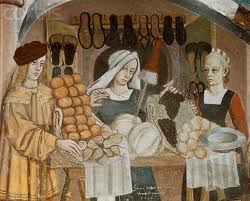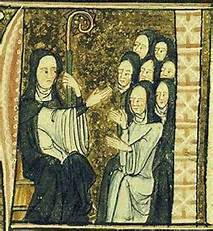Today Dr Schrader continues her mini-series on opportunities for women in the Middle Ages with a look at women's access to economic power.
Nothing
gives women more power and status than wealth. In societies where women
cannot own property (e.g. ancient Athens) they are not only powerless
to take their fate into their own hands in an emergency, they are also
generally viewed by men as worthless. Where women can possess, pass-on,
and control wealth, they enjoy independence, respect and are viewed
(and coveted) not only as sexual objects but as contributors to a man’s
status and fortune (e.g. ancient Sparta).
Medieval
women across Europe could inherit, own and dispose of property. The
laws obviously varied from realm to realm and over time, but the
fundamental right of women to inherit was widespread and reached from
the top of society (women could in many but not all realms bequeath
kingdoms) to the bottom, where peasant women could also inherit and
transmit the hereditary rights to their father’s lands, mill or shop.
Significantly, it was not only heiresses
that enjoyed property and the benefits thereof. On the contrary, every
noblewoman received land from her husband’s estate at marriage called a
“dower.”
A
dower is not to be confused with the dowry. A dowry was not an
inheritance. It was property that a maiden took with her into her
marriage. Negotiated between families before a marriage, dowries were
usually land. Royal brides brought entire lordships into their marriage
(e.g. the Vexin), but the lesser lords might bestow a manor or two and
the daughters of gentry might bring a mill or the like to their
husbands. Even peasant girls might call a pasture or orchard their
dowry. The key thing to remember about dowries, however, is that they
were not the property of the bride. They passed from her guardian to her husband.
Dowers, on the other hand, were women’s property. In the early Middle Ages, dowers were inalienable
land bestowed on a wife at the time of her marriage. A woman owned and
controlled her dower property, and she retained complete control of this
property not only after her husband’s death, but even if her husband
were to fall foul of the king, be attained for treason, and forfeit his
own land and titles.
Whatever the source of a woman's wealth, in Medieval France, England and Outremer, women did not
need their husband’s permission or consent to dispose over their own
property. There are thousands of medieval deeds that make this point.
While it was common to include spouses and children on deeds, this was a
courtesy that increased the value of the deed rather than a necessity ―
and that principle applied to men as well as women. Thus many deeds
issued by kings and lords included wives and children as witnesses as a
means of demonstrating that the grant or sale was known to their
co-owners/heirs.
Middle-class
women could inherit whole businesses, and as widows they ran these
businesses, representing them in the respective guilds. Indeed, most
wives were active in their husband's business while he was still alive.
Manuscript illustrations show, for example, a women bankers (collecting
loans, while the husband gives them out), and "alewives" -- including
women in helmets bringing refreshment to archers engaged in a battle! (I
could not find that picture on the internet, but here's another
allegorical picture of women fighting.)
More important, however, women could learn and engage in trades and business on their own. They could do this as widows, as single, unmarried women (femme sole)
or as married women, running a separate business from that of their
husbands. The skills acquired, even more than property, fostered
economic independence and empowerment because property can be lost — in a
fire, an invasion, from imprudence and debt — but skills are mobile and
enduring, as long as one remains healthy enough to pursue one’s
profession. Furthermore, once qualified in a trade, women took part in
the administration of their respective profession, both as guild-members
and on industrial tribunals that investigated allegations of fraud,
malpractice and the like. In short, there was no discrimination against qualified women engaged in a specific trade.
Furthermore,
women in the Middle Ages could learn a variety of trades. Some trades
were dominated by women, for example, in England brewing, in France
baking, and almost everywhere silk-making. However,
women were also very frequently shopkeepers, selling everything from
fruit and vegetables (not very lucrative) to spices and books. In
addition, women could be, among other things, confectioners,
candle-makers, cobblers, and buckle-makers. Women could also be
musicians, copiers, illuminators, and painters, though I have not come
across references to women sculptors. More surprising to modern readers,
medieval records (usually tax rolls) also list women coppersmiths,
goldsmiths, locksmiths, and armorers. A survey of registered trades in
Frankfurt for the period from 1320 to 1500 shows that of a total 154
trades, 35 were reserved for women, but the remainder were practiced by both men and women, although men dominated in 81 of these.
Notably,
in the early Middle Ages women could be medical practitioners. All
midwives were women, of course, and sisters of the Hospital provided
most of the care for women patients, but women could also be barbers
(who performed many medical procedures such as blood-letting),
apothecaries, surgeons, and physicians. A female doctor, for example,
accompanied King Louis IX on crusade in the mid-13th century. Women
learned these trades in the traditional way, by apprenticing with
someone already practicing the profession, who was willing to take them
on. It wasn't until the 14th century that universities imposed the
exclusive right to certify physicians -- while excluding women from
universities.
All
Dr Schrader's novels set in the Middle Ages strive to show women as active
participants in society and the economy.
For
readers tired of clichés and cartoons, award-winning novelist Helena P.
Schrader offers nuanced insight into historical events and figures
based on sound research and an understanding of human nature. Her
complex and engaging characters bring history back to life as a means to
better understand ourselves.
Find out more at: https://www.helenapschrader.com/crusades.html









































